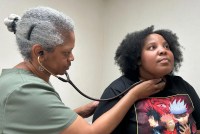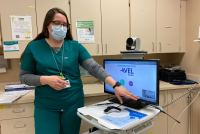Cash Shortages and Complex Rules Impede Native American Health-Care Access
Each year, the Indian Health Service rejects tens of thousands of requests to fund outside care that it doesn’t provide, forcing patients to go without treatment or pay big medical bills themselves. The IHS is supposed to provide free care to Native Americans, but it does so only at scattered clinics and hospitals the agency funds and then manages […]
Patients Suffer When Indian Health Service Doesn’t Pay for Outside Care
The Indian Health Service has a program that can pay for outside appointments when patients need care not offered at agency-funded sites. Critics say money shortages, complex rules, and administrative fumbles often block access, however.
World-Famous Wall Drug Isn’t Immune From Challenges Facing Rural Pharmacies
Even as part of a popular South Dakota tourist attraction, an independent pharmacy serving locals, remote ranchers, and sightseers struggles with staffing and insurer payments.
Montana Creates Emergency ‘Drive-Thru’ Blood Pickup Service for Rural Ambulances
The network is aimed at helping rural patients, who face higher rates of traumatic injuries and death but may not live near a hospital with a stockpile of blood.
Native Americans Have Shorter Life Spans. Better Health Care Isn’t the Only Answer.
Social services, such as parenting classes and economic development programs, can help increase the life spans of Native Americans, some health experts say. But insurers don’t always cover these services.
Montana, an Island of Abortion Access, Preps for Consequential Elections and Court Decisions
A 25-year-old state Supreme Court ruling protects abortion rights in conservative Montana. That hasn’t stopped Republicans and anti-abortion advocates from trying to institute a ban.
A Government Video Would Explain When Abortion Is Legal in South Dakota
South Dakota allows doctors to terminate a pregnancy only if a patient’s life is in jeopardy. Lawmakers say a government-created video would clarify what that exception actually means.
What a Bison Goring Can Teach Us About Rural Emergency Care
Millions of Americans live in “ambulance deserts” — areas that are more than a 25-minute drive to the nearest emergency medical services (EMS) station. The most rural areas can be more than an hour away from help. These sparsely populated communities can have trouble sustaining ambulance services, if small patient volumes and low reimbursements […]
Doctors on (Video) Call: Rural Medics Get Long-Distance Help in Treating Man Gored by Bison
A rural South Dakota medic said using an ambulance video system to communicate with a doctor gave him peace of mind as he treated a patient who was seriously injured when gored by a bison.
Medical School on Cherokee Reservation Will Soon Send Doctors to Tribal, Rural Areas
Native Americans and rural residents are underrepresented in medical schools. But in this new program, 25% of students are Indigenous and half are from rural areas.
She Received Chemo in Two States. Why Did It Cost So Much More in Alaska?
A breast cancer patient who received similar treatments in two states saw significant differences in cost, illuminating how care in remote areas can come with a stiffer price tag.
With Its Two Doctors Planning to Retire, an Alabama Town Patches Together Health Care Options
LaFayette and other rural areas of the country tend to have high rates of health problems but not enough doctors. Many are adapting by investing in nontraditional prevention and treatment options.
The DEA Relaxed Online Prescribing Rules During Covid. Now It Wants to Rein Them In.
Supporters say the proposed rules would balance the goals of increasing access to health care and helping prevent medication misuse. Opponents say the rules would make it difficult for some patients — especially those in rural areas — to get care.
Thousands Face Medicaid Whiplash in South Dakota and North Carolina
Thousands of South Dakotans are being knocked off Medicaid, only to be eligible to requalify several months later. Even more enrollees are likely to experience a temporary loss of coverage in North Carolina.
Community Paramedics Don’t Wait for an Emergency to Visit Rural Patients at Home
Community paramedicine is expanding nationwide, including in rural areas, as health care providers, insurers, and state governments recognize its potential to improve health and save money.
Truly Random Drug Testing: ADHD Patients Face Uneven Urine Screens and, Sometimes, Stigma
Doctors have no national standards on when to order urine tests to check whether adult ADHD patients are properly taking their prescription stimulants. Some patients are subjected to much more frequent testing than others.
It Takes a Village: Foster Program Is a New Model of Care for Indigenous Children
A foster care program on the Cheyenne River Reservation in South Dakota is attracting attention from officials elsewhere as they search for ways to reduce trauma inflicted on Indigenous families, who’ve faced generations of high rates of family separation.
Telehealth Brings Expert Sexual Assault Exams to Rural Patients
Some rural residents must travel hours for a sexual assault exam. Specialized telehealth services are expanding so they can obtain care closer to home.
South Dakota Voters Approved Medicaid Expansion, but Implementation May Not Be Easy
South Dakotans voted to expand the state’s Medicaid program to cover thousands of additional low-income residents. But as other conservative states have shown, voter approval doesn’t always mean politicians and administrators will rush to implement the change.
Campaigning Ramps Up as South Dakota Voters Decide on Medicaid Expansion
A broad coalition of Medicaid expansion supporters faces off against a smaller group of opponents as early voting begins on a constitutional amendment that would increase coverage under South Dakota’s program.


























